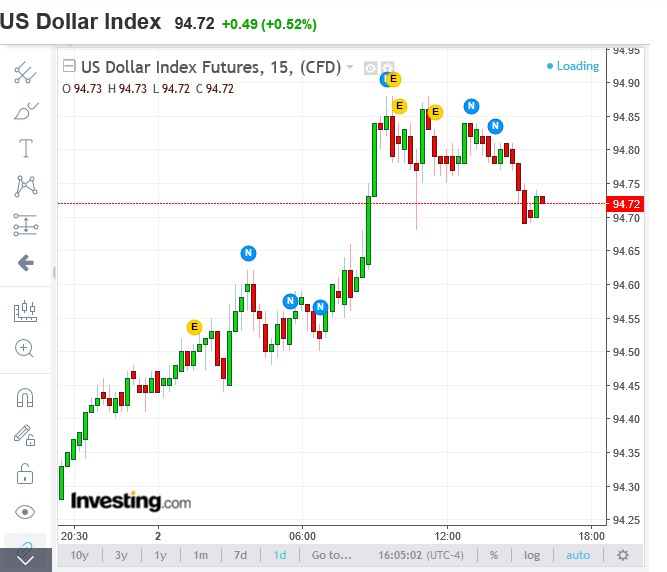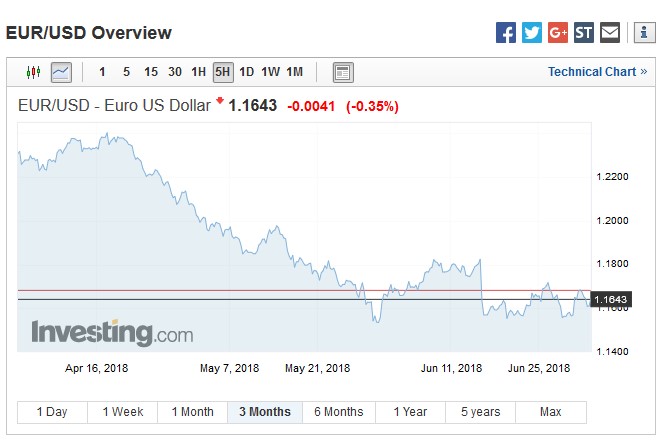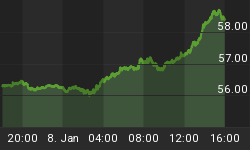In the midst of all the talk about trade wars, both real and imagined, one slugger has emerged as the unlikely winner—the U.S. dollar.
The dollar has inched 0.62 percent higher on Monday trading, adding to a 0.4 percent gain on the previous trading session as an important watershed moment in the unfolding tit-for-tat trade tariffs approaches.
Investors are jittery about July 6, the deadline when Washington is due to impose $34 billion in tariffs on Chinese exports.

(Click to enlarge)
Source: Investing.com
China, which has found itself at the epicenter of a heated trade dispute between the U.S. and its trading partners, is expected to respond in kind by imposing its own tariffs on U.S. exports. An all-out showdown between the world’s largest economies is likely to put the skids on global trade and investments as well as convulse financial markets. Related: Three Key Takeaways From Mexico’s Elections
Investors have been scooping up the greenback as a safe haven bet as evidenced by dollar long positions, which edged higher for the second week running.
The dollar was able to extend its gains even further after data from the Institute for Supply Management (ISM) showed that manufacturing activity had surged during the month of June.
The ISM manufacturing index for the month clocked in at 60.2, an improvement compared to 58.7 in May. An ISM reading above 50 indicates an expansion in manufacturing activity. The metric is an important indicator of economic health because manufacturing contributes about 12 percent to the U.S. economy.
The positive ISM reading though can be interpreted in other less benign ways. It’s likely that the index climbed due to supply chain disruptions in steel and aluminum industries after Trump’s punitive tariffs took effect.
In his first trade offensive against American allies in May, president Trump slapped hefty tariffs on steel and aluminum imports from the EU, Canada and Mexico. The ISM supplier deliveries sub-index climbed to 68.2 last month, a 6.2-point increase that points to a lengthening in suppliers’ delivery times.
Lengthening supply times are taken as a sign of increased manufacturing activity, which clearly might not be the case this time around.
Weaker Euro=Stronger Dollar
The dollar’s rise is also being aided by a weakening euro. The dollar strengthens when the euro weakens and vice-versa because the euro makes up nearly 60 percent of the dollar index.
Political tensions in the eurozone as well as low interest rates are to blame.
Unlike the U.S., which is currently under a period of monetary tightening, the European Central Bank decided to leave interest rates at historic lows leading to a rout for the regional currency.
The euro has slipped six percent against the greenback over the past three months alone.

(Click to enlarge)
Source: Investing.com
With all the ongoing trade snafu, president Trump might inadvertently have achieved his wish to have a stronger greenback.
Related: “Father Of The Web” Fights Back Against Internet Centralization
In January, the president declared:
"The dollar is going to get stronger and stronger and ultimately I want to see a strong dollar."
But an overly strong dollar is not necessarily a good thing. Unlike corporate equities where rising values are almost always welcomed (by the longs), rising currencies can be just as problematic as falling ones. First off, it makes buying dollar denominated commodities more expensive which can be harmful to exports. And a strong dollar is almost always bad news for gold prices.
On an investment level, it can wipe out the positive effects of tax cuts by introducing severe FX headwinds. That’s especially true for companies with large exposures to foreign markets, of which many top performers do have. Falling earnings tend to precipitate stock selloffs, not to mention falling or stagnating dividends.
By Alex Kimani for Safehaven.com
More Top Reads From Safehaven.com:

















